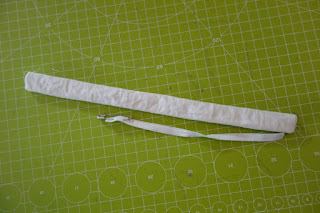Earlier this year a class prompt came up at the Harry Potter Knitting and Crochet House Cup that asked for tea related projects. It inspired me to conduct a little bit of an experiment that I want to share here, even though it's been a while. I did not have a lot of experience with plant dyes yet, but I was aware that the treatment of the wool prior to and after dyeing can have tremendous influence on the resulting colour. So I decided to find out how this applies to black tea.
I reskeined some undyed wool into small skeins à 25 g and gathered my supplies - I would be limited to five attempts by the number of yogurt jars I own (I should really start buying yogurt in jars again):
Then I prepared the mini-skeins for dyeing.
#1, #4 and #5 : just water
#2 : water with 5g alum
#3 : water with 5g alum and 2 g cream of tartar
So no mordant in jars #1, #4 and #5? No. Since black tea contains tannins that act as a mordant you don't HAVE to pre-mordant your wool. But it might have an interesting effect to do so anyway... But let's come back to this later...
I put all the jars in the oven at 90°C for about 2 hours, then let the wool cool down in the jars over night.
The next morning I prepared some really strong black tea - 72 tea bags (126 g) of a Ceylon / Assam blend on 2.2 l of water. Wouldn't recommend to drink that...
I let that concoction cool down to almost room temperature before I took out the tea bags (giving them a good sqeeze to make sure I did not loose too much of my dye). Then I combined what was left (1.8 litres) in one bowl and added 200 ml of water to come back to a full 2 litres (I would need 400 ml per jar).
Then (it was afternoon by now) I got the wool out of the jars, rinsed the skeins treated with alum / alum + CoT and gave each skein a good spin in my new salad spinner before placing it back into its jar. I filled the jars with dye to cover the wool…
…and put all 5 jars in the oven again at 90°C. When I came back from the playground about 2 hours later I switched of the oven, but kept the jars in for another hour before I took them out and placed them on the balcony to cool down.
Samples #1, #2 and #3 would receive no further treatment besides rinsing. And there already seemed to be a visible difference in the colours of those dye baths!
When the wool had cooled down enough later that night, the wool in jars #4 and #5 should receive their respective special treatment. I removed the wool from the dye baths and gave it a bit of a squeeze, but did NOT rinse it. I poured out the dye and prepared:
#4: a solution of a pinch of potassium carbonate in 400 ml of water.
#5: a solution of ferrous sulfate in 400 ml of water. My research indicated not to use more than 2% of the weight of the fibre treated - in this case 0.5 g. I went with a tiny pinch of the stuff because my kitchen scales do not measure such tiny amounts (precision scales are the next item on my shopping list…).
I replaced the skeins… and the effect was breathtaking! The contents of jar # 5 (on the left) turned pitch black!
Again, heat treatment, this time for just about an hour. Then lots of rinsing.
Thanks to the salad spinner the yarn took just a day to dry. And here’s the result:
Just as a reminder:
#1: no mordants whatsover
#2: pre-mordanted with alum
#3: pre-mordanted with alum + cream of tartar
#4: not pre-mordanted, treated with potassium carbonate after dyeing
#5: not pre-mordanted, treated with ferrous sulfate after dyeing
Every single sample came out a different shade of brown - although the differences between #1, #4, #2 and #3 may be subtle and hard to capture with a camera. In real life #1 has a visible orange tinge that is not as present in #4. Equally, #3 has a slight reddish tinge that is not as visible in #2.
Another interesting observation that I had read about and that I can confirm is that #2 feels less soft than the other skeins (hot alum mordanting has that effect - which can be avoided by adding cream of tartar - but as we can see, this can also cause a different outcome in colour).
The most visible and most stunning result, though, is the colour produced by after mordanting with ferrous sulfate. That dark (rather “cold”) brown just stands out against all the other - rather warm - shades of lighter brown I got.
So do I have plans for my tea dyed wool? Yes! In fact I do: I want to make a naalbound hat - with stripes! Hopefully some day soon...



























